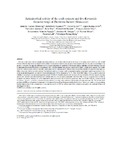| dc.description.abstract | The aim of this study was to evaluate the antimicrobial activity of the crude extract of the twigs of Dorstenia barteri (DBT) as well as that
of four of the five flavonoids isolated from this extract. Gram-positive bacteria (six species), Gram-negative bacteria (12 species) and fungi (four
species) were used. The agar disc diffusion test was used to determine the sensitivity of the tested samples while the well micro-dilution was used
to determine the minimal inhibition concentrations (MIC) and the minimal microbicidal concentration (MMC) of the active samples. The results
of the disc diffusion assay showed that DBT, isobavachalcone (1), and kanzonol C (4) prevented the growth of all the 22 tested microbial species.
Other compounds showed selective activity. The inhibitory activity of the most active compounds namely compounds 1 and 4 was noted on 86.4%
of the tested microorganisms and that of 4-hydroxylonchocarpin (3) was observed on 72.7%. This lowest MIC value of 19.06 g/ml was observed
with the crude extract on seven microorganisms namely Citrobacter freundii, Enterobacter aerogens, Proteus mirabilis, Proteus vulgaris, Bacillus
megaterium, Bacillus stearothermophilus and Candida albicans. For the tested compounds, the lowest MIC value of 0.3 g/ml (on six of the 22
organisms tested) was obtained only with compound 1, which appeared as the most active compound. This lowest MIC value (0.3 g/ml) is about
4-fold lower than that of the RA, indicating the powerful and very interesting antimicrobial potential of isobavachalcone (1). The antimicrobial
activities of DBT, as well as that of compounds 1, 3, 4, amentoflavone (5) are being reported for the first time. The overall results provide promising
baseline information for the potential use of the crude extracts from DBT as well as some of the isolated compounds in the treatment of bacterial
and fungal infections. | en |

